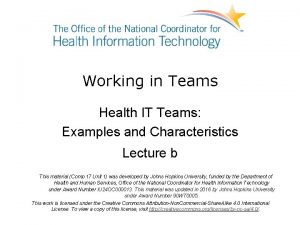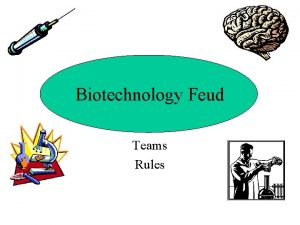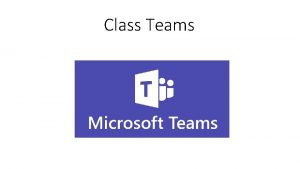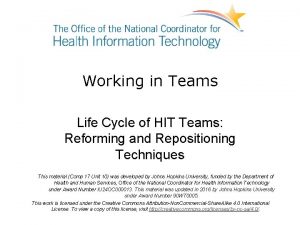Working in Teams Health IT Teams Examples and

















- Slides: 17

Working in Teams Health IT Teams: Examples and Characteristics Lecture a This material (Comp 17 Unit 1) was developed by Johns Hopkins University, funded by the Department of Health and Human Services, Office of the National Coordinator for Health Information Technology under Award Number IU 24 OC 000013. This material was updated in 2016 by Johns Hopkins University under Award Number 90 WT 0005. This work is licensed under the Creative Commons Attribution-Non. Commercial-Share. Alike 4. 0 International License. To view a copy of this license, visit http: //creativecommons. org/licenses/by-nc-sa/4. 0/.

Health IT Teams: Examples and Characteristics Learning Objective—Lecture a • Describe the characteristics of an effective team and work group. • Identify and differentiate roles of IT health care professionals in teams. • Describe the value of teams and the importance of collaboration for the IT professional in teams. 2

The Health IT Field is Diverse and Expansive 3

Teamwork in HIT Teams and teamwork are important aspects of health care delivery today. In a complex health care setting, it takes many teams to run the system, deliver safe patient care, and to ensure a smooth throughput process for patients and families. 4

Reflection • Before you learn more about HIT teams, please list three teams you have served on during the past three years. What role did you play? What was the key skill/activity you had to perform? What was the team goal and was it identified? 5

Team—Definition • A team is defined as “a small number of people with complementary skills who are committed to a common purpose, performance, goals, and approach for which they hold themselves mutually accountable. ” (Harvard Business Review, 1993) 6

Important Features of Team Members • • • Communication Coordination Distinctive roles Interdependent tasks Shared norms 7

Examples of Health Information Team Members 8

Other Important Team Members engaged in HIT • • Software Development Medical Device Suppliers Quality Improvement Professionals Oversight & Regulatory Agencies 9

Viewing Teams as a Three-Stage System Teams are often viewed as a three-stage system that includes: 1. Input—Resources teams utilize 2. Throughput —Maintenance of internal processes 3. Output—Production of specific products 10

Characteristics of Effective Teamwork 1. Organizational structure 2. Individual contribution 3. The actual processes that the team is involved in 11

Characteristics of Effective Teamwork Table 12

Organizational Structure Components • • • Clear purpose/mission Appropriate culture Specified task Distinct roles Leadership 13

Health IT Teams: Examples and Characteristics Summary—Lecture a • It is important to understand the characteristics of an effective team as healthcares settings are complex. • Most health care environments require teamwork to run the systems and deliver safe patient care. 14

Health IT Teams: Examples and Characteristics References—Lecture a— 1 References • Harvard Business Review. (1993) The Discipline of Teams. • Katzenbach JR, Smith DK. (1993) The Wisdom of Teams: Creating the High. Performance Organization, Harper Business, New York. • Mickan S, Rodger S. Characteristics of effective teams: a literature review. Australian Health Review. 23(3): 201 - 208. 2000. • Norm N. The Value of Teams in the Workplace. The University Record. 1996 Oct 8; Available from: http: //www. ur. umich. edu/9697/Oct 08_96/artcl 15 c. htm • Richard AG, Dickson MW. Teams in Organizations: Recent Research on Performance and Effectiveness. Annual Review of Psychology. 47(1): 307 -338. 1996. • Zeff LE, Higby MA. Teaching More Than You Know. Academic Exchange Quarterly. 6(3). 2002. 15

Health IT Teams: Examples and Characteristics References—Lecture a— 2 Charts, Tables, Figure • Table 1. 1. Characteristics of Effective Teamwork. Adapted from Mickan S, Rodger S: Characteristics of effective teams: a literature review. Australian Health Review 2000, 23(3): 201 -208. Available from: http: //www. biomedcentral. com/1472 -6963/7/17 Images • Slide 3: Keyboard and stethoscope. Courtesy of Department of Health and Human Services. Available from: http: //www. healthit. gov • Slide 4: Clinicians. Image courtesy The Johns Hopkins Hospital • Slide 8: Nurse checking patients blood pressure. Image courtesy National Institutes of Health (NIH). Available from: https: //www. nih. gov/news-events/images 16

Working in Teams Health IT Teams: Examples and Characteristics Lecture a This material (Comp 17 Unit 1) was developed by Johns Hopkins University, funded by the Department of Health and Human Services, Office of the National Coordinator for Health Information Technology under Award Number IU 24 OC 000013. This material was updated in 2016 by Johns Hopkins University under Award Number 90 WT 0005. 17
 Proses pengerjaan panas
Proses pengerjaan panas Leading and working in teams
Leading and working in teams Hot working and cold working difference
Hot working and cold working difference Cold working and hot working
Cold working and hot working Differentiate between hot working and cold working
Differentiate between hot working and cold working Teamwork in the public services
Teamwork in the public services Team norms
Team norms Hard work vs smart work
Hard work vs smart work Unit 2 working in health and social care
Unit 2 working in health and social care Health and social care unit 2
Health and social care unit 2 Ashwg
Ashwg Health and social component 3
Health and social component 3 Chapter 10 motivating and satisfying employees and teams
Chapter 10 motivating and satisfying employees and teams Motivating and satisfying employees and teams
Motivating and satisfying employees and teams Is the individual internal process that energizes directs
Is the individual internal process that energizes directs Motivating and satisfying employees and teams
Motivating and satisfying employees and teams Motivating and satisfying employees and teams
Motivating and satisfying employees and teams Difference between health education and physical education
Difference between health education and physical education

































